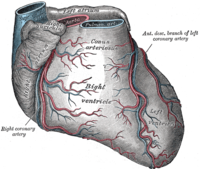| Coronary circulation | |
|---|---|
| An anterior view of the heart shows the right coronary artery and the anterior descending branch of the left coronary artery. | |
| Base and diaphragmatic surface of heart. | |
| MeSH | Coronary+Vessels |
Coronary circulation is the circulation of blood in the blood vessels of the heart muscle. Although blood fills the chambers of the heart, the muscle tissue of the heart (the myocardium) is so thick that it requires coronary blood vessels to deliver blood deep into it. The vessels that deliver oxygen-rich blood to the myocardium are known as coronaryarteries. The vessels that remove the deoxygenated blood from the heart muscle are known as coronary veins.
The coronary arteries that run on the surface of the heart are called epicardial coronary arteries. These arteries, when healthy, are capable of autoregulation to maintain coronary blood flow at levels appropriate to the needs of the heart muscle. These relatively narrow vessels are commonly affected byatherosclerosis and can become blocked, causingangina or a heart attack. (See also: circulatory system.) The coronary arteries that run deep within the myocardium are referred to as subendocardial.
The coronary arteries are classified as "end circulation", since they represent the only source of blood supply to the myocardium: there is very little redundant blood supply, which is why blockage of these vessels can be so critical.
(wikipedia.org)


No comments:
Post a Comment